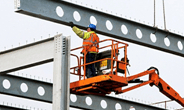Steel Markets

AGC: Record Job-Openings Curb Construction Employment in March
Written by David Schollaert
April 19, 2022
Construction employment exceeded pre-pandemic levels in just 32 states in March, as record-high job openings held back hiring, said the Associated General Contractors of America (AGC) in its latest analysis of federal employment data.
![]()
“Contractors have been adding workers as fast as they can find them,” said Ken Simonson, AGC’s chief economist. “But there just aren’t enough qualified workers available in many states, as shown by the record number of construction job openings at the February.”
There were 364,000 job openings in construction at the end of February, a 52% jump in openings from a year earlier – the highest February total since 2021 when the government first compiled the data. That figure exceeded February’s 342,000 construction hires, implying that construction firms would have added twice as many employees if they had been available, the economist asserted.
From February 2020 – the month before the pandemic caused projects to be halted or canceled – through March 2022, construction employment increased in 32 states, declined in 16 states and the District of Columbia, and was unchanged in Nevada and Wyoming.
Utah added the most construction jobs since February 2020, a boost of 15,000 workers, or 13.2% higher, followed by Tennessee (+11,400 or +8.6%) and Missouri (+11,300 or +8.8%). Utah also had the largest percentage gain, followed by South Dakota (+12.1% or +2,900) and Idaho (+12.0% or +6,600).
New York shed the most construction jobs over the 25-month period, down 29,600 works, or -7.2%, followed by Texas (-15,300 or -2.0%) and Pennsylvania (-14,200 or -5.3%). The largest percentage losses were in New York, Pennsylvania, and North Dakota (-5.0% or -1,400).
February construction employment increased in 35 states, decreased in 14 states and D.C., and was unchanged in Idaho. California added the most construction jobs during the month, adding 8,900 to payrolls, or up 1.0% MoM, followed by Texas (+4,400 or +0.6%) and North Carolina (+4,200 or +1.8%). South Dakota had the largest percentage gain, expanding by 7.1%, or 1.800 new jobs, followed by New Mexico (+3.3% or +1,700) and Connecticut (+2.1% or +1,300).
New York lost the most construction jobs over the same period, down -3,700 workers, or -1.0%, followed by Colorado (-2,300 or -1.2%) and Mississippi (-1,600 or -3.3%). Mississippi had the largest percentage loss as well, followed by West Virginia (-1.8% or -600), and Wyoming (-1.7% or -400).
A lack of workers is delaying critically needed projects, the association said, urging officials in Washington to boost the industry by increasing funding for career and technical education.
“Contractors are eager to hire more workers,” said Stephen Sandherr, AGC’s CEO. “The federal government must expand opportunities for appropriate education and training programs.”
By David Schollaert, David@SteelMarketUpdate.com

David Schollaert
Read more from David SchollaertLatest in Steel Markets

CMC looks beyond Arizona micro-mill woes to long-term viability of construction mart
Despite the economic and geopolitical upheaval of the last five years, CMC President and CEO Peter Matt points out that the construction market has been an essential element of the way forward.

US importers face stricter rules under revamped S232 tariffs
“CBP expects full compliance from the trade community for accurate reporting and payment of the additional duties. CBP will take enforcement action on non-compliance," the agency said in a March 7 bulletin.

Steel exports rebound in January
US steel exports recovered to a five-month high in January after having fallen to a two-year low in December. This growth follows four consecutive months of declining exports.

Construction spending drops marginally in January
Construction spending edged down slightly in January, slipping for the first time in four months. The US Census Bureau estimated spending at a seasonally adjusted annual rate of $2,196 billion in January, down 0.2% from December’s downward revised rate. The January figure is 3.3% higher than a year ago. January’s result, despite the slight erosion, […]

HVAC equipment shipments slow in December but strong annually
Shipments of heating and cooling equipment in the US fell to an 11-month low in December, according to the latest data released by the Air-Conditioning, Heating, and Refrigeration Institute (AHRI).
